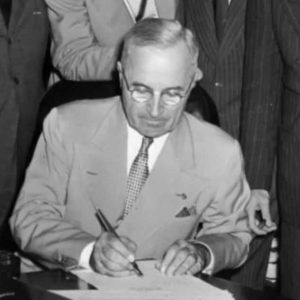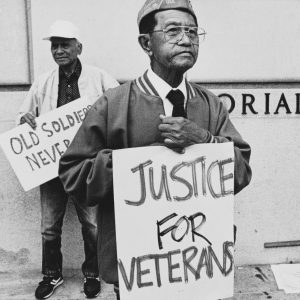Lesson Plan 6:
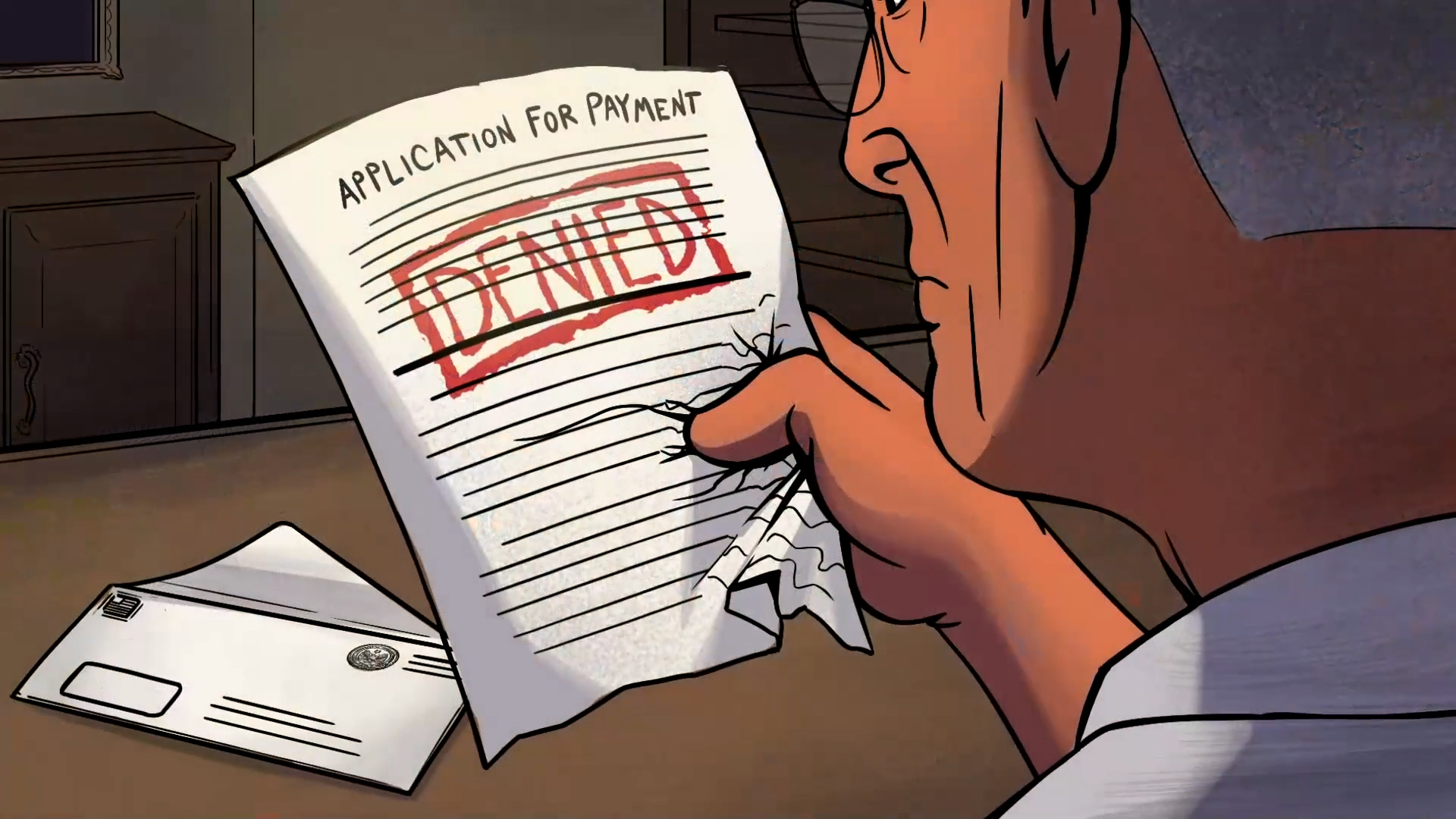
Comparing the G.I. Bill and the Rescission Act
Students read a short text and complete a graphic organizer to compare and contrast two key laws that affected World War II veterans; includes suggested adaptations for lower-level readers.
Summary
In this lesson, students compare and contrast two key laws that affected World War II veterans. Students define “benefits” and list examples of those conferred by the G.I. Bill. They then learn about a law, the Rescission Act, that denied those benefits to Filipino veterans. Two different versions of the reading are offered, one with additional text supports/definitions to support lower-level readers.
Key Ideas
1. After World War II, most veterans were rewarded for their service, including with loans to purchase homes and pursue higher education, through a law called the GI Bill of Rights.
2. Filipino veterans were denied these benefits because of a specific law (The Rescission Act) intended to deny them, and only them, from these benefits.
3. After the Rescission Act, Filipino veterans fought for more than 70 years to get benefits and recognition.
Time
35-40 minutes
Materials
- Handout: The G.I. Bill and the Rescission Act (two versions provided)
Grade Level/Subject
Middle School Social Studies (differentiated texts included)
Common Core: Middle School
- CCSS.ELA-LITERACY.RH.6-8.2 Determine the central ideas or information of a primary or secondary source; provide an accurate summary of the source distinct from prior knowledge or opinions.
UCLA Public History Initiative | US History Content Standards
- Era 9, Standard 3: Domestic policies after World War II
- Era 9, Standard 4: The struggle for racial and gender equality and the extension of civil liberties
Teacher Background
Throughout American history, the idea that the government has a special responsibility to care for its veterans has been a powerful ideal and rallying cry. Concerns about the Continental Congress’s ability to deliver its promised pensions roiled Revolutionary War armies. Over the course of the 19th century, the federal government and states evolved a system of pensions, hospitals and homes for elderly poor and disabled veterans. After World War I, in the midst of the Great Depression, Great War veterans staged the first march on Washington to demand their promised bonuses; the Veterans Administration was finally established in 1930.
Passed unanimously in Congress and signed by FDR in 1944, the Servicemen’s Readjustment Act, better known as the GI Bill, provided tuition, cost-of-living, books and supplies, equipment and counseling services for veterans to continue their education. It provided government-backed loans so returning veterans could purchase homes. The bill also ensured that veterans’ hospitalization needs would be taken care of. Approximately 8 million veterans received educational benefits over the next seven years, costing about $14.5 billion. By 1955, 4.3 million home loans had been granted, with a face value of $33 billion. The bill also appropriated half a billion dollars for the construction of new veteran hospitals. The long-term economic impact of this bill is in the trillions of dollars, as home values increased over time and became a source of generational wealth to pass onto children and grandchildren, veterans used their college degrees to move up the economic ladder into the middle class, and other ripple effects.
Compare that to the Filipino veterans’ situation. At the end of World War II, after years of high government spending to support the war effort, Congress was looking for ways to trim the U.S. budget. In 1946, a “rescission” bill, to rescind or cut funds that had previously been appropriated, was introduced; if passed, it would cut or save the U.S. about $52 billion. Among the costs that budget-conscious Congressmen identified were veterans benefits for Filipinos who had served in the U.S. armed forces during the war. An October 1945 report from the Veterans Administration estimated that the lifetime cost of benefits for Filipinos would be about $3.2 billion.
At the same time, the U.S. was set to fulfill the promise of the Tydings-McDuffie Act and finally grant independence to the Philippines. In a solemn ceremony on July 4, 1946, the U.S. flag was lowered and the Philippine Republic’s flag was raised in Manila’s central park. Despite wartime orders from President Roosevelt and General MacArthur making clear that Filipinos who fought for the U.S. were full members of the U.S. armed forces, members of Congress argued that the Philippines now had the responsibility of caring for Filipino veterans. To help them do so, Congress added a rider to the rescission bill. It provided a one-time $200 million-dollar payment to the Philippines government to help them provide veterans care. It also stated that Filipinos who served in the U.S. military during the war would henceforth not be considered veterans, and therefore not entitled to any veterans benefits from the United States government.
The confluence of these two events, post-war cost-cutting measures and the declaration of an independent Philippines, was disastrous for Filipino veterans. The 1946 Rescission Act declared that they alone, of all people who had served in the U.S. military during World War II, would be denied veterans benefits.
Instructions
1. Introduction (up to 10 minutes): Veterans’ Benefits
Start by asking students to list what risks and sacrifices veterans make in order to serve in the U.S. military. These could include: risk of being injured or killed during combat; time away from family; time in military rather than pursuing an education or other career; and during service military personnel follow restrictions for behavior, dress, personal movement, etc.
After considering these risks and sacrifices, ask students to think of what would be fair ways to repay veterans for their service. These could include: monetary payments, providing health care, providing homes, paying for higher education, being honored/recognized in public.
2. Defining the G.I. Bill and the Rescission Act (15 minutes)
Together, in pairs, or independently, have students read the handout about the G.I. Bill and the Rescission Act. As they read, ask students to underline or highlight examples of benefits. Ask students to circle the people who were affected by each law.
There are two versions of the handout, one with definitions. You can use these to differentiate the lesson for different level readers. The total word count is 568; the Flesch-Kincaid Grade Level estimate is 6.6 or Seventh Grade
3. Comparing the Laws (10 minutes)
After students finish reading the handout, ask them to share out examples of benefits they found. Ask them to name who each law affected. Check for understanding by asking students to name which law conferred benefits and which law denied benefits.
For ESL/ELL students, you can also create concept maps to break down the text’s main ideas and/or preview key vocabulary terms (duration, sabotage, tuition, petition). Main concepts include:
- World War II created veterans (those who had served in the military)
- 200,000 WWII veterans were Filipinos
- The G.I. Bill of Rights was a major law passed in 1944 that gave special benefits to WWII veterans:
- Money to pursue their education, buy a home, or start a loan
- Free medical care for life
- For non-citizens, right to immigrate and/or become U.S. citizens
- Big idea: the U.S. government had a responsibility to care for veterans
- The Rescission Act was a little-known law passed in 1946 that denied benefits to Filipino veterans
- No money for education, homes, or businesses
- No access to medical care
- No right to immigrate and/or become U.S. citizens
- Big idea: the U.S. government took no responsibility for Filipino veterans
- Protest:
- Filipino veterans did not accept the Rescission Act
- Filipino veterans protested for more than 70 years to try to gain back their benefits
Then ask students to draw a Venn Diagram and label one side “G.I. Bill” and one side “Rescission Act.” Working independently or in pairs, ask students to complete the diagram using information from the handout.
4. Concluding Discussion: Analyzing the Effects of the Laws (5 minutes)
Wrap up the lesson by asking students to share what both laws have in common and what was different about each law. Then ask students to analyze the effects of the laws; potential questions include:
- Why did the U.S. pass the G.I. Bill?
- Who benefited from the G.I. Bill? Who was excluded from the G.I. Bill?
- Why did the U.S. pass the Rescission Act?
- What benefits were denied to Filipino veterans because of the Rescission Act?
- Did the U.S. break its promise to Filipino veterans?
If time, tap students’ prior knowledge about the history of veterans benefits, or share points from the teacher background. Then ask students to consider why previous generations of veterans had been (mostly) successful but that it took Filipino veterans protesting for 70 years to gain even partial recognition and benefits. Potential discussion questions include:
- What are times when veterans were able to petition for benefits successfully?
- What methods have American veterans used to gain benefits over time? What do their (mostly) successful efforts suggest about the democratic process?
- Why, compared to other veterans, did it take 70 years of protest for Filipino veterans to gain recognition or benefits?
- How did the facts of the colonization and independence of the Philippines affect Filipino veterans’ ability to petition Congress?
Related Explainers
The G.I. Bill and the Rescission Act
(Version A) Higher Reading Level
Directions:
As you read, underline or highlight examples of benefits. After reading the entire passage, go back to circle the groups of people affected by each law.
More than 16 million Americans served in World War II between 1941 and 1945. Soldiers, sailors and Marines risked their lives in order to fight for their country. More than 400,000 were killed in action. More than 670,000 were injured. The average duration of military service was 33 months–almost three years.
Of the 16 million servicemen and women, about 200,000 were Filipinos who fought with the U.S. Armed Forces against the Japanese in the Philippines. These veterans included soldiers who were part of the United States Army Forces in the Far East (USAFFE) and guerrillas. Some guerrillas had formal military training and coordinated their actions with the U.S. military. Many others fought the Japanese on their own to protect their homeland. Sometimes guerrillas conducted direct combat with Japanese soldiers. Other times they committed acts of sabotage, like stealing supplies or sharing illegal information, to undermine the Japanese.
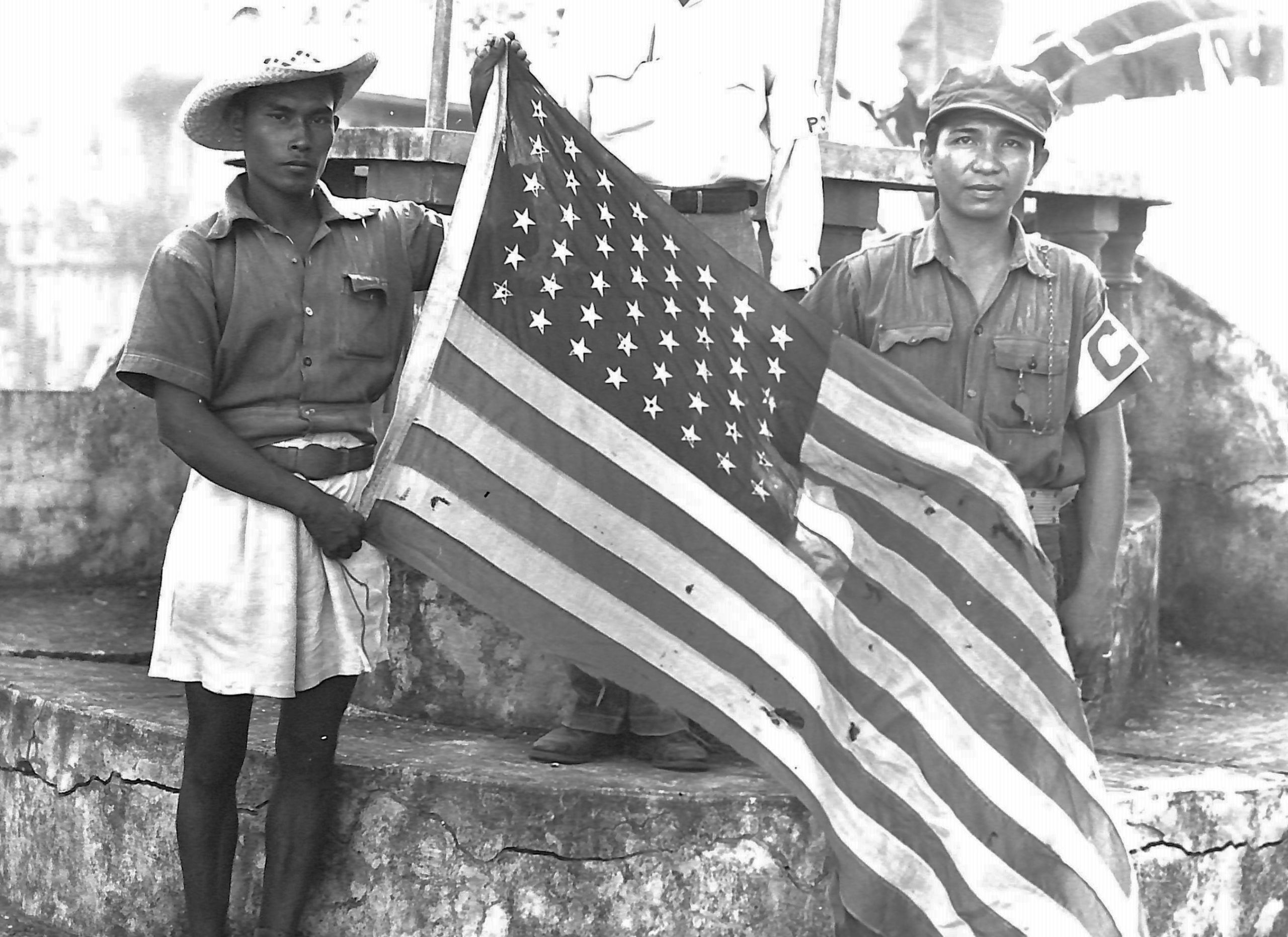
Filipino Veterans with U.S. Flag, circa 1945
In 1944, Congress passed a law called the Servicemen’s Readjustment Act. It was designed to help returning veterans readjust to American life, and to repay them for their service and sacrifices during the war. This law came to be known as the G.I. Bill of Rights.
The G.I. Bill included many benefits for veterans. First, it paid for veterans to go to college. The “educational benefit” included tuition, books, supplies, and counseling services. About 8 million veterans received the educational benefit over the next seven years
Second, the G.I. Bill provided loans to veterans so that they could buy houses, farms or start a business. More than 4.3 million home loans were granted. The total value of these loans was $33 billion.
The G.I. Bill also paid for new hospitals that would only serve veterans. These Veterans Administration (VA) hospitals provided free healthcare for life to World War II veterans.
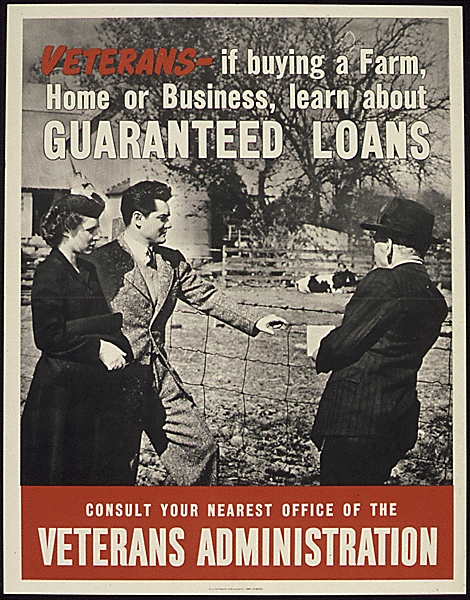
G.I. Bill posters, circa 1945
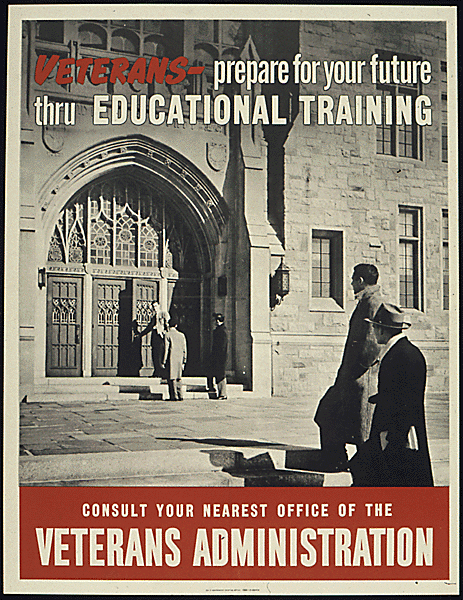
However, Filipino veterans did not get to obtain the benefits of the G.I. Bill. In 1946, Congress was looking for ways to save money after the war. Congress passed a new law to cut them off from veterans benefits. This law was called the Rescission Act. (“Rescission” is related to the word “scissors;” both mean “to cut.”) The law said that Filipino veterans were not considered to be part of the U.S. military, despite declarations from President Roosevelt and General McArthur during the war.
Instead of paying for veterans benefits, the Rescission Act proposed a one-time, $200 million payment to the Philippines government to pay small pensions to Filipino veterans. The Philippines government was insulted by this offer and rejected the payment.
The Rescission Act also prevented Filipino veterans from immigrating to the United States. At the time, U.S. immigration laws prevented almost all immigration from Asia. A law passed in 1940 said that non-citizens who served in the U.S. Armed Forces could earn their U.S. citizenship. But the Rescission Act prevented Filipino veterans from enjoying this benefit.
Filipino veterans protested the Rescission Act for more than 75 years. They filed lawsuits, petitioned Congress to change the law, and committed acts of civil disobedience. Finally, in 2009, a small amount of money was put aside to make small payments to living veterans, most of whom were in their 80s and 90s.
Although the U.S. government made great promises to its veterans with the G.I. Bill, they broke those promises to Filipino veterans with the Rescission Act.
(Version b) Simplified Text
Directions:
As you read, underline or highlight examples of benefits. After reading the entire passage, go back to circle the groups of people affected by each law.
More than 16 million Americans served in World War II between 1941 and 1945. Soldiers, sailors and Marines risked their lives in order to fight for their country. More than 400,000 were killed in action. More than 670,000 were injured. The average duration of military service was 33 months–almost three years.
Of the 16 million servicemen and women, about 200,000 were Filipinos who fought with the U.S. Armed Forces against the Japanese in the Philippines. These veterans included soldiers who were part of the United States Army Forces in the Far East (USAFFE) and guerrillas. Some guerrillas had formal military training and coordinated their actions with the U.S. military. Many others fought the Japanese on their own to protect their homeland. Sometimes guerrillas conducted direct combat with Japanese soldiers. Other times they committed acts of sabotage, like stealing supplies or sharing illegal information, to undermine the Japanese.
Guerrillas: Non-professional military forces, who usually fight in small groups with hit-and-run tactics or acts of sabotage.
Sabotage: To deliberately destroy or damage something, usually for military or political gain

Filipino Veterans with U.S. Flag, circa 1945
In 1944, Congress passed a law called the Servicemen’s Readjustment Act. It was designed to help returning veterans readjust to American life, and to repay them for their service and sacrifices during the war. This law came to be known as the G.I. Bill of Rights.
The G.I. Bill included many benefits for veterans. First, it paid for veterans to go to college. The “educational benefit” included tuition, books, supplies, and counseling services. About 8 million veterans received the educational benefit over the next seven years
Second, the G.I. Bill provided loans to veterans so that they could buy houses, farms or start a business. More than 4.3 million home loans were granted. The total value of these loans was $33 billion.
The G.I. Bill also paid for new hospitals that would only serve veterans. These Veterans Administration (VA) hospitals provided free healthcare for life to World War II veterans.
G.I. was the nickname for a serviceman during World War II. It stands for “Government Issue.” Most of the clothes, weapons and supplies used by servicemen included the phrase “G.I.” stamped on them, hence the nickname.
Tuition: Money to pay for education

G.I. Bill posters, circa 1945

However, Filipino veterans did not get to obtain the benefits of the G.I. Bill. In 1946, Congress was looking for ways to save money after the war. Congress passed a new law to cut them off from veterans benefits. This law was called the Rescission Act. (“Rescission” is related to the word “scissors;” both mean “to cut.”) The law said that Filipino veterans were not considered to be part of the U.S. military, despite declarations from President Roosevelt and General McArthur during the war.
Instead of paying for veterans benefits, the Rescission Act proposed a one-time, $200 million payment to the Philippines government to pay small pensions to Filipino veterans. The Philippines government was insulted by this offer and rejected the payment.
The Rescission Act also prevented Filipino veterans from immigrating to the United States. At the time, U.S. immigration laws prevented almost all immigration from Asia. A law passed in 1940 said that non-citizens who served in the U.S. Armed Forces could earn their U.S. citizenship. But the Rescission Act prevented Filipino veterans from enjoying this benefit.
Filipino veterans protested the Rescission Act for more than 75 years. They filed lawsuits, petitioned Congress to change the law, and committed acts of civil disobedience. Finally, in 2009, a small amount of money was put aside to make small payments to living veterans, most of whom were in their 80s and 90s.
Although the U.S. government made great promises to its veterans with the G.I. Bill, they broke those promises to Filipino veterans with the Rescission Act.
Pension: A regular payment paid to someone after they retire so that they continue to have income.
Petition: To make a formal request, usually in writing.

